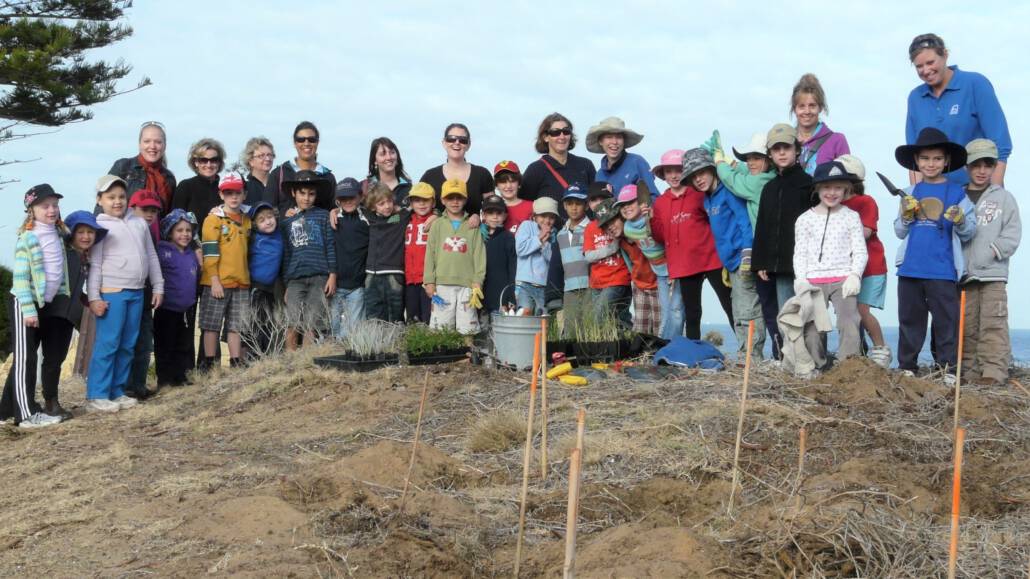Mudurup
Mudurup Rocks is the limestone promontory at the eastern end of the groyne at the Cottesloe main beach. It surrounds the sundial and has beautiful views across the Cove and south to Fremantle.
Cottesloe Coastcare has worked at Mudurup Rocks over many years. Synergy and Landcare sponsored a project here in 2009/10 and $35,000 was spent on a limestone retaining wall and pine log fencing. After controlling for weeds and rabbits we planted 4000 local native plants. Coastcare volunteers collected and cleaned all the seed required for the new plants. We continue to plant here to fill in bare patches and weed and collect rubbish.
Staff from Synergy and Coca Cola have helped with planting and weeding. Quintilian and Hale School students also joined in planting sessions and a team from Woodside removed masses of weeds. As always Coastcare is very grateful for this support given to our work towards the restoration of Town of Cottesloe’s natural areas.
After volunteers collect seed from a project site we send the seed to specialist nurseries to grow the plants . Ben Croxford of Nuts about Natives Nursery takes on the challenge of growing some of our more recalcitrant species and his skills are vital. Where there are too few local plants remaining in Cottesloe to provide seed Ben propagates from cutting material. APACE Nursery in Fremantle have also been great partners with Coastcare since we began in 1995.
You can see a list of the plants that occur at this site here.
Place of the Yellow-finned Whiting
For Aboriginal people Mudurup is a place of special significance and the name means “place of the yellow finned whiting”. More here. Noongar stories say this is the traditional haunt of the crow or warrdung. Their stories of Kadjil the Crow man say that when he visited Mudurup, fish such as mullet and salmon would be arriving soon. You can read more here.
It is also a place where you can see evidence of geological history. The layers of rocks at The Cove show how sea levels have varied over millennia. As recently as 7000 years ago you could still walk to Rottnest. More about the geology of Mudurup here.

2009 Mudurup verge when we started.

2019 A flourishing verge at Mudurup.

2010 More planting near the Cottesloe Surf Club

2017 Same site flourishing.

2010 Montessori children helped us with planting.

2014 A weeding working bee with Woodside.
What we are protecting
Weedy Seadragon

The seaward side of Mudurup Rocks runs into the Cottesloe Reef which is home to the Weedy Seadragon (Phyllopteryx taeniolatus). Weedy Seadragons can grow up to 45cm in length. They have leaf-like appendages for camouflage and a few short spines along their body used as a defence against attacking fish. Their bodies are orange/red with yellowish or whitish spots and may have bluish purple stripes and some yellow markings. Breeding season is early summer and male seadragons carry the fertilised eggs on their tail for up to two months. The baby sea dragons hatch small but fully formed and swim off to fend for themselves.
In 2010 Cottesloe Coastcare began a campaign to have Weedy Seadragons protected in Western Australia. Success came in June 2011 when “weedies” were declared a protected species. You can read more here.
Native Wisteria (Hardenbergia comptoniana)

Hardenbergia comptoniana or native wisteria is a vigorous climbing plant with cylindrical fruit. The 10 mm long pods pop open on hot summer days. Ants are attracted to the white ‘fat bodies’ around the seeds and collect and bury the seeds thereby increasing the plants’ dispersal.
The genus was named in 1837 by George Bentham in honour of Franziska, Countess von Hardenberg (sister of Baron von Huegel). Was it because Franziska had beautiful green eyes or because she was a patron of botany?
Related stories
Kadjil the Crow man
28 November 2014/by Sue FreethWonderful Woodside weeders
4 November 2014/by Robyn BenkenAnother great PwC team
8 December 2013/by Sue Freeth‘I love Cottesloe coast’ Facebook launched
29 October 2013/by Robyn BenkenThe last seedling is planted for 2013!
28 July 2013/by Robyn BenkenAnd the ospreys came too….
25 April 2013/by Sue FreethKings Park Master Gardeners come to visit
15 November 2012/by Robyn BenkenThe watering team from Hale
20 March 2011/by Robyn BenkenCottesloe Coastcare Association
PO Box 32
Cottesloe WA 6911
info@cottesloecoastcare.org
Sign up to our Newsletters
To stay up to date with our news and upcoming events.
